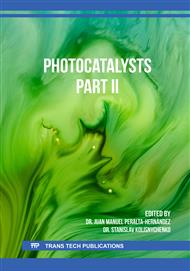[1]
Q.L. Ma, Y.F. Yu, M. Sindoro, A.G. Fane, R. Wang, H. Zhang, Carbon‐Based Functional Materials Derived from Waste for Water Remediation and Energy Storage, Adv. Mater. 29 (2017)1605361–1605379.
DOI: 10.1002/adma.201605361
Google Scholar
[2]
M.A. Shannon, P.W. Bohn, M. Elimelech, J.G. Georgiadis, B.J. Marinas, A.M. Mayes, Science and technology for water purification in the coming decades, Nature. 452 (2008) 301–310.
DOI: 10.1038/nature06599
Google Scholar
[3]
J. Tian, Y.H. Leng, Z.H. Zhao, Y. Xia, Y.H. Sang, P. Hao, J. Zhan, M.C. Li, H. Liu, Carbon quantum dots/hydrogenated TiO2 nanobelt heterostructures and their broad spectrum photocatalytic properties under UV, visible, and near-infrared irradiation, Nano Energy. 11 (2015) 419–427.
DOI: 10.1016/j.nanoen.2014.10.025
Google Scholar
[4]
S.A. Mozaffari, M. Ranjbar, E. Kouhestanian, H.S. Amoli, M.H. Armanmehr, An investigation on the effect of electrodeposited nanostructured ZnO on the electron transfer process efficiency of TiO2based DSSC, Mater. Sci. Semicond. Process. 40 (2015) 285-292.
DOI: 10.1016/j.mssp.2015.06.081
Google Scholar
[5]
M.Y. Guo, M.K. Fung, F. Fang, X.Y. Chen, A.M.C. Ng, A.B. Djuriˇsi´c, W.K. Chan, ZnO and TiO2 1D nanostructures for photocatalytic applications, J. Alloys Compd. 509 (2011) 1328-1332.
DOI: 10.1016/j.jallcom.2010.10.028
Google Scholar
[6]
M. J. Torralvo, J. Sanz, I. Sobrados, J. Soria, C. Garlisi, G. Palmisano, S. Cetinkaya, S. yurdakal, V. Augugliaro, Anatase photocatalyst with supported low crystalline TiO2: The influence of amorphous phase on the activity, Appl. Catal. B: Environ. 221(2018) 140-151.
DOI: 10.1016/j.apcatb.2017.08.089
Google Scholar
[7]
M. Yeganeh, N. Shahtahmasebi, A. Kompany, The magnetic characterization of Fe doped TiO2 semiconducting oxide nanoparticles synthesized by sol–gel method. Phys. B. 511(2017) 89-98.
DOI: 10.1016/j.physb.2017.02.010
Google Scholar
[8]
K. C. Sung, P. Chang, Fabrication and enhanced photocatalytic property of TiO2-ZnO composite photocatalysts, Mater. Lett. 30(2018) 58-52.
Google Scholar
[9]
M. Acerce, D. Voiry, M. Chhowalla, Metallic 1T phase MoS2 Nanosheets as Supercapacitor Electrode Materials, Nat. Nano technol. 10(2015)313-318.
DOI: 10.1038/nnano.2015.40
Google Scholar
[10]
C. L. He, J. Liu, Q. Yao, T. Chen, L. Yan, W. Hu, F. Jiang, Y. Zhao, Y. Hu, T. Sun, Z. Wei, Vacancy-Induced Ferromagnetism of MoS2 Nanosheets, J. Am. Chem. Soc. 137(2015)2622-2627.
DOI: 10.1021/ja5120908
Google Scholar
[11]
S. S. Chou, Y. K. Huang, J. Kim, B. Kaehr, B. M. Foley, P. Lu, C. Dykstra, P. E. Hopkins, C. J. Brinker, J. Huang, V. P. Dravid, Controlling the Metal to Semiconductor Transition of MoS2 and WS2 in Solution, J. Am. Chem. Soc. 137(2015)1742-1745.
DOI: 10.1021/ja5107145
Google Scholar
[12]
L. Wang, Z. Xu, W. Wang, X. Bai, Atomic Mechanism of Dynamic Electrochemical Lithiation Processes of MoS2 Nanosheets, J. Am. Chem. Soc. 136(2014)6693-6697.
DOI: 10.1021/ja501686w
Google Scholar
[13]
D.P. Wu, X.L. Wang, H.J. Wang, F.J. Wang, D.Q. Wang, Z.Y. Gao, X.J. Wang, F. Xu, K. Jiang, Ultrasonic-assisted synthesis of two dimensional BiOCl/MoS2 with tunable band gap and fast charge separation for enhanced photocatalytic performance under visible light, J. Colloid Interface Sci. 533 (2019) 539–547.
DOI: 10.1016/j.jcis.2018.08.084
Google Scholar
[14]
L. Chen, J. He, Q. Yuan, S.F. Yin, Environmentally benign synthesis of branched Bi2O3–Bi2S3 photocatalysts by an etching and re-growth method, J Mater Chem A. 3(2014) 1096-1102.
Google Scholar
[15]
Y. Yin, J. Han, Y. Zhang, Z. Zhang, Contributions of Phase, Sulfur Vacancies, and Edges to the Hydrogen Evolution Reaction Catalytic Activity of Porous Molybdenum Disulfide Nanosheets, J Am Chem Soc. 138 (2016) 7965-7972.
DOI: 10.1021/jacs.6b03714
Google Scholar




